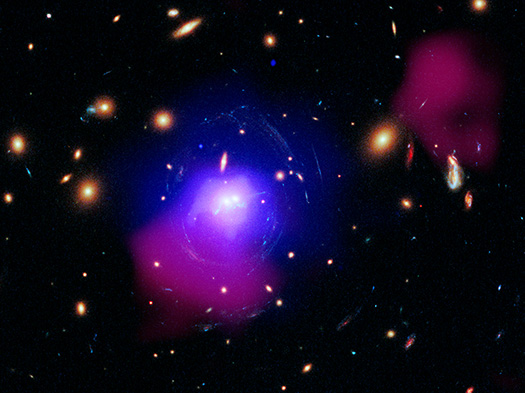For Release: February 21, 2024
NASA/CXC
Astronomers have discovered one of the most powerful eruptions from a black hole ever recorded. This mega-explosion billions of years ago may help explain the formation of a striking pattern of star clusters around two massive galaxies, resembling beads on a string.
This discovery was made in the system known as SDSS J1531+3414 (SDSS J1531 for short), which is located 3.8 billion light-years from Earth. Several telescopes were used for this study, including NASA’s Chandra X-ray Observatory and the Low Frequency Array (LOFAR), a radio telescope.
SDSS J1531 is a massive galaxy cluster containing hundreds of individual galaxies and huge reservoirs of hot gas and dark matter. In the heart of SDSS J1531, two of the cluster’s largest galaxies are colliding with each other. Surrounding these merging giants is a set of 19 large clusters of stars, called superclusters, arranged in an ‘S’ formation that resembles beads on a string. A team of astronomers used X-ray, radio, and optical data to unravel how this unusual chain of star clusters likely formed.
Their discovery of evidence for an ancient, titanic eruption in SDSS J1531 provided a vital clue. The eruption likely occurred when the supermassive black hole in the center of one of the large galaxies produced an extremely powerful jet. As the jet moved through space, it pushed the surrounding hot gas away from the black hole, creating a gigantic cavity.
Osase Omoruyi, who led the study at the Center for Astrophysics | Harvard & Smithsonian (CfA), compared finding this cavity to unearthing a buried fossil. “We are already looking at this system as it existed four billion years ago, not long after the Earth formed,” she said. “This ancient cavity, a fossil of the black hole’s effect on the host galaxy and its surroundings, tells us about a key event that happened nearly 200 million years earlier in the cluster’s history.”
The evidence for a cavity comes from “wings” of bright X-ray emission, seen with Chandra, tracing dense gas near the center of SDSS J1531. These wings make up the edge of the cavity and the less dense gas in between is part of the cavity. LOFAR shows radio waves from the remains of the jet’s energetic particles filling in the giant cavity. Together, these data provide compelling evidence of an ancient, massive explosion.
The astronomers also discovered cold and warm gas located near the opening of the cavity, detected with the Atacama Large Millimeter and submillimeter Array (ALMA) and the Gemini North Telescope, respectively. They argue that some of the hot gas pushed away from the black hole eventually cooled to form cold and warm gas. The team thinks tidal effects from the two merging galaxies compressed the gas along curved paths, leading to the star clusters forming in the “beads on a string” pattern.
“We’ve reconstructed a likely sequence of events in this cluster that occurred over a vast range of distances and times. It began with the black hole a tiny fraction of a light-year across forming a cavity almost 500,000 light-years wide”, said co-author Grant Tremblay, also from the CfA. “This single event set in motion the formation of the young star clusters nearly 200 million years later, each a few thousand light-years across.”
Omoruyi and her colleagues only see radio waves and a cavity from one jet, but black holes usually fire two jets in opposite directions. The team has observed radio emission farther away from the galaxies that might be the leftovers from a second jet, but it is not associated with a detected cavity. They surmise that the radio and X-ray signals from the other eruption might have faded to the point that they are undetectable.
“We think our evidence for this huge eruption is strong, but more observations with Chandra and LOFAR would clinch the case,” said Omoruyi. “We hope to learn more about the origin of the cavity we’ve already detected, and find the one expected on the other side of the black hole.”
The paper led by Osase Omoruyi describing these results is published in The Astrophysical Journal and is available online here. Besides Omoruyi and Tremblay the authors of the paper are Francoise Combes (Paris Observatory, France), Timothy Davis (Cardiff University, UK), Michael Gladders (University of Chicago), Alexey Vikhlinin (CfA), Paul Nulsen (CfA), Preeti Kharb (National Centre for Radio Astrophysics - Tata Institute of Fundamental Research, India ), Stefi Baum (University of Manitoba, Canada), Christopher O’Dea (University of Manitoba, Canada), Keren Sharon (University of Michigan), Bryan Terrazas (Columbia University), Rebecca Nevin (Fermi National Accelerator Laboratory), Aimee Schechter (University of Colorado Boulder), John ZuHone (CfA), Michael McDonald (Massachusetts Institute of Technology), Hakon Dahle (University of Oslo, Norway), Matthew B. Bayliss (University of Cincinnati), Thomas Connor (CfA), Michael Florian (University of Arizona), Jane Rigby (NASA Goddard Space Flight Center), and Sravani Vaddi (Arecibo Observatory).
NASA's Marshall Space Flight Center manages the Chandra program. The Smithsonian Astrophysical Observatory's Chandra X-ray Center controls science operations from Cambridge, Massachusetts, and flight operations from Burlington, Massachusetts.
Media Contact:
Megan Watzke
Chandra X-ray Center, Cambridge, Massachusetts
617-496-7998
mwatzke@cfa.harvard.edu
Jonathan Deal
Marshall Space Flight Center, Huntsville, Alabama
256-544-0034
jonathan.e.deal@nasa.gov



